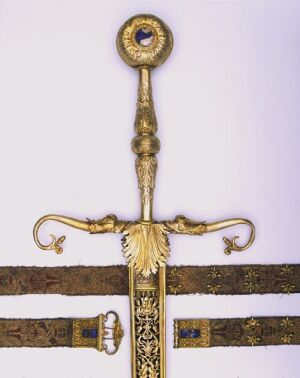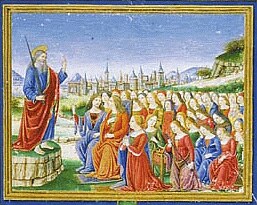|
Renaissance (1300-16th century)
|
Buda Workshop
The Missale of Matthias Corvinus 1488-1489 Parchment, VII (calendar) and 233 folios; 35.1 x 25.2 cm Latin text with black texture Large size figural initials representing scenes on golden base, with body colour, canon picture and whole pages of decoration. Binding: brown leather Open: canon picture (104v); T(e igitur) in initial Vir Dolorum, and frame decoration (105r) Biblioteca Apostolica Vaticana, Urb-Lat. 110 The manuscript was made for
King Matthias in the Buda workshop. The coat of arms of Matthias and his
wife Beatrix of Aragon can be found on several pages. Certain heraldic
elements, like the raven and the patriarchal cross occur in the frame and
in one of the initials. (fol. 1r, 104v, 105r, 149r, 188v) As the Hungarian
escutcheon is often represented together with the Austrian, the terminus
post quem of the codex is the entrance of King Matthias to Vienna (1485).
The codex is containing the Missal romanum plenum beside the calendar.
Hevesy presumes that it must be a Franciscan missale, as an octave is given
to St Francis.The hypothesis is supported by the fact that the feast of
St Louis is marked with red (rubrum) in the calendar. It is probable that
the missal was ordered by the king for the Franciscans, since another Vatican
missal was ordered by him for the Franciscans as well (Ross. 1164). The
title page’s motif of the framing band with precious stones was taken over
from a missal of Matthias made in the workshop of Attavante (Brussels,
Bibliothéque Royale, MS 9008). The stylistic orientation of the
Buda workshop was however not towards Florence, but Lombardy. The most
important source of this is the activity of the miniaturist signed ‘Franciscus
de Castello Ithalico de Mediolano’ in Buda, which is proved by two decorated
documents made out in the chancellery of Buda in 1481 (M. C. und die Renaissance
1982, 414-415 cat. no). The signature of the master can be found in two
places on the richly decorated breviary of Domonkos Kálmáncsehi,
Provost of Székesfehérvár (Budapest Széchenyi
Nat. Libr., Cod. Lat. 446). The stylistic elements and motifs can be found
in several codices made in Buda, like the provost’s breviary dated to 1481
and his missal (New York, Pierpont Morgan Library, G. 7) or the present
missal. Hevesy had already perceived the similarity between the praying
King David’s ‘A’ initial put together of architectural elements and cornucopia
(fol. 1r) and a miniature of Christophoro de Predis. The Crucifixion on
fol 104v also has a Lombardian prototype. Still, it is clear that it came
into being northwards the Alps because of the way the town is delienated,
which obviously has its origin in the Low Countries. A similar view decorates
a gradual ordered by Matthias (Budapest Széchenyi Nat. Libr. Cod.
Lat. 424). The parallels of the ornament on folio 188v can be found on
the title-page of the gradual. This work was made in Buda and preserved
otherwise lost Netherlandish compositions. The acanthus leaves of the title-page
and the canon, the gilt surfaces, the rocks show that the codex was influenced
by the second Lombardian wave labelled by the name of the master of the
Codex Cassianus (Bibliotheque Nationale, Ms. Lat. 2129). The activity of
the master in Buda between 1489-1498 prove that work continued there after
the death of Matthias.
|
 |
Hungarian handicraft
Kutassy chasuble Hungarian needlework, c. 1470 Silver-knitted silk based Venetian brocade with flat gold embroidery; 127 x 74 cm Esztergom, Cathedral Treasury, inv. no: 64.299.1 Archbishop János Kutassy (1597-1601) had acquired it when he was still Bishop of Pécs, around 1590, and had his coat of arms put on it only later. Under embroidered canopies, the Virgin is represented in the circle of Hungarian saints: St Stephen, László, Imre, Gellért and Jerome, who was often considered as a Hungarian saint because of his Dalmatian origin.
|
 |
Domenico
da sutri and Bernardo di Ser Silvano
The sword of the Hungarian King Ulászló II Rome, 1509 Steel, gilded and enameled silver, and woven golden brocade; Length: 158.2 cm Hungarian National Museum, Armoury, Budapest. inv. no: 55.3235 The gilded silver wide cross-bar is curved towards the blade and ends in acorns. The very long grasp is decorated with acanthus leaves, while the large sized, disc shaped pommel is enameled. At the beginning of the blade the figure of St Peter can be seen, on the other end there is the figure of St Paul. On both plates of the blade there is the inscription JULIUS II. PONT. MAX. ANNO VII. dating it to 1509. The text is followed by the coat of arms of the donator, Pope Julius II and the engraved oak tree of the Della Rovere family. The gilded silver sheath is decorated with dolphins and grotesque ornament with acanthus leaves. On the sheath there is an enamel plate with the papal arms. The magnificent golden brocade belt belonging to the sword is decorated with the Rovere coat of arms, the papal tiara, and the keys of St Peter. The motifs are connected with scrolls and foliage.The silver gilt buckle of the belt is decorated with Gothic rosettes. The sword was made by Domenico de Sutri, goldsmith of the Pope, and the belt by Bernardo Ser Silvano. The sword was handed over by the papal legate to King Ulászló II in the summer of 1510. The sword is an early piece of the papal swords of outstanding artistic quality. |
 |
Statue of the Virgin with the Child
from Tüskevár (?)
C. 1460-70 Poplar tree, painted, gilded; Height: 33.5 cm Budapest, Hungarian National Gallery, inv. no: 52.640 The medieval colours of the statue can be reconstructed based on the result of the restoration: the Virgin wore a golden cloak with blue lining, and a gilded dress under it, the underdress was red. The colouring of the body surfaces has remained almost untouched. The rear side of the figure is deeply grooved, so it might have stood in a winged altar. The origin of the statue from Tüskevár could be neither proved, nor disproved. It got to the collection of Kálmán Darnay at the end of 19th century. According to family tradition he found it together with another statue (HNM, inv. no: 58.27.M) among the ruins of the Paulite convent of Tüskevár-Nagyjenô. The stylistic parallels of the statue, considered to be the most beautiful of the 1460’s-1470’s, can be found in the Salzburg sculpture of the same period. The soft ”S” line of the body, the oval face, the gesture of the raised right hand holding a sceptre, the figure of the Child, the forming of the pleats appear on the Madonna of the high altar of the parish church of Kitzbühel, the statue of the Virgin in the Museum Carolino Augusteum, Salzburg (inv. no: 164/32), or on the Madonna from Tamsweg. In the Hungarian sculpture the nearest parallel is the Madonna of the St Michael church in Sopron, the half-length figure of the Virgin in the church of Dozmat and the Virgin of Ják. Reputedly, the statue got to the Darnay collection in Sümeg from the ruins of the Paulite convent of Tüskevár, from there to the Balaton Museum, Keszthely. In 1938 the Museum of Fine Arts exchanged it, then it has become the property of the Hungarian National Gallery. |
 |
Transylvanian goldsmith’s
work
The chalice of Benedek Suky C. 1440 Gilded silver, cast, embossed, engraved, floral cloissoné enamel fields, rich architectural decoration; Height: 27.2 cm Esztergom, Cathedral Treasury, inv. no: 64.21.1 The thirty tiny keel-arched niches are decorated with the cast statues of saints and angels. Medallions and an eucharistic prayer with Gothic minuscules: Ave vas clemencie... are engraved on the cup. On the base the donating inscription can be read: calice istu fecit fieri benedictus de swk nobilis transsilvanus p ipm q huic eclie co donatus. (Benedek Suky, Transylvanian nobleman commissioned this chalice and gave it to this church). Benedek Suky is listed among the Transylvanian nobles in the period between 1437 and 1439, and donated the chalice to the Cathedral of Gyulafehérvár. During the time of the Reformation, in 1557, it was taken by Bishop István Ilosvai to Nagyszombat, where the archbishopric and the chapter were staying at that time. |
